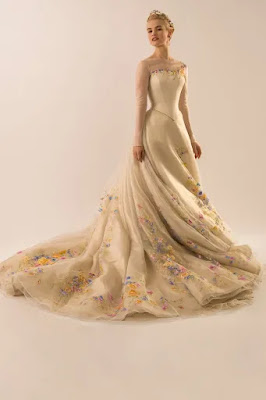Editor’s note: What perfect weekend read! Fairy tales! Weddings! Fashion! Kelly informs and entertains in this deep dive into fairy tales and what we wear as a result of reading them. Follow the links, as they are really fun—Kelly really did her homework. (Kate)
It is hard to deny the transformative power of a beautiful dress. When I was a teenager, my grandmother, who was languishing in the final days of a long illness, mistook a pink crystal ring my boyfriend had given me for an engagement ring, and immediately began thinking about wedding gowns. “We will have to find you the most beautiful dress,” she whispered, running her wrinkled hands across the folds of the rough hospice blankets on her bed, as if she might magically turn them into sweeping mounds of bridal silk. From that moment on, the imagined sheen of “pretty new dresses” filled her waking hours, and a hope for the future danced in her dying eyes. My grandmother passed away long before I married the boy who had given me the pink crystal ring, but when he twirled me across the dance floor at our wedding reception, I prayed that she was looking down from heaven to see the beautiful sequined ball gown that billowed behind me.
No piece of clothing marks the transition from one phase of life to another more than a wedding dress, and weddings are inextricably linked in our minds with fairy tales. Although fairy tale weddings leave much to be desired (Snow White’s mother dances to her death in red-hot iron shoes at her daughter’s wedding and Cinderella’s sisters have their eyes poked out at her nuptials), Disney films have made the idea of fairy tale weddings famous, often ending with opulent ceremonies. An internet search of the phrase “fairy tale wedding” yields thousands of links to gowns, cakes, and venues designed to provide every couple with their piece of happily ever after.
Fairy tale fashion is not limited to weddings; characters like Little Red Riding Hood and Puss-in-Boots are named for the clothes they wear. In 2016, the Museum at the Fashion Institute of Technology in New York City presented an exhibition on Fairy Tale Fashion, and Yale University Press published a book of the same name featuring over 150 photographs and illustrations to complement its investigation of fairy tale couture.
Cinderella is the fairy tale protagonist best known for transforming her life through fashion, trading her rags for a dress that makes her the object of the prince’s desire. Perrault provides the girl with a fairy godmother who has a solid fashion sense; she touches Cinderella with her wand giving her “garments of gold and silver cloth” before sending her off to the ball in style. The Grimm version of the tale describes a hazel tree which tosses down beautiful dresses over three separate nights and a Scottish variant features a dress-giving cow, but in each version of the story, it is the dress which signals Cinderella’s transformation from persecuted daughter to powerful maiden. When Disney produced its live action Cinderella movie in 2015, the company spent an incredible amount of time and money designing both the iconic blue ball gown and the wedding dress the heroine dons at the conclusion of the film.
Cinderella, ATU 510A, is closely related to ATU 510B, stories of “unnatural love”. In tales like Perrault’s Donkeyskin and Grimm’s All-Kinds-of-Fur, the protagonist delays marrying her own father by requesting dresses that echo the beauty of the sun, moon, and stars. When royal seamstresses create the beautiful gowns, the girl packs them away and disguises herself in the skin of beasts, often serving in the kitchens of a prince who eventually becomes her husband. At every turn in these stories, the other-worldly dresses act as signals of the heroines’ constant transformations, both protecting her from harm and allowing her entry into the highest levels of society. In his book On the Nature of Fairy Tales, Max Luthi explores the celestial dresses described in these stories, noting that “one cannot express more beautifully how the world is woven into the clothing of man in the fairy tale.”
Another fairy tale known for its fashionableopulence is Beauty and the Beast, ATU 425C. This “tale as old as time” can be traced back to the story of Cupid and Psyche and often features an active heroine who must quest for her lost husband and return him to human form. The most popular literary version, published by Beaumont in 1756, features many elements found in Cinderella stories including plotting sisters and access to material beauty. When Disney filmed its live action version of Beauty and the Beast in 2017, the company devoted considerable attention to designing Belle’s iconic ball gown and using her costumes to reflect her position as Disney’s first feminist princess. While fashion and feminism may seem at odds, the two topics have a long history, with the evolution of popular dress styles reflecting the arc of female liberation and transformation over time.
We never outgrow our love for the perfect dress, that sacred swath of fabric that lights us up from the inside and reveals who we are beneath the surface. When my grandmother died, we buried her in a “pretty new dress,” sewn of a cloth that matched the soft blue shade of her eyes. Though earthly concerns were beyond her, it seemed only fitting that she have a dress to signal her transformation from body to spirit, a dress to reflect the kindness of her soul. My grandmother has been gone for over twenty-five years, but on lonely days, I still feel the ache of her loss. Those are the days that I throw on the prettiest dress in my closet and go outside to search for her. I find her in the sequined sparkle of sunlight swirling through the trees. I find her in the silky sheen of sunset shadows. I find her in the twirls and folds of the brilliant blue sky. With every azure sweep of heaven’s billowing ball gown, my sorrow is supplanted by gratitude for my grandmother’s love and thankfulness for the transformative power that a beautiful fairy tale dress can have on the human heart.
***
Bio: Kelly Jarvis teaches classes in literature, writing, and fairy tale at Central Connecticut State University, The University of Connecticut, and Tunxis Community College. She lives, happily ever after, with her husband and three sons in a house filled with fairy tale books. She is also Enchanted Conversation’s special project’s writer.





